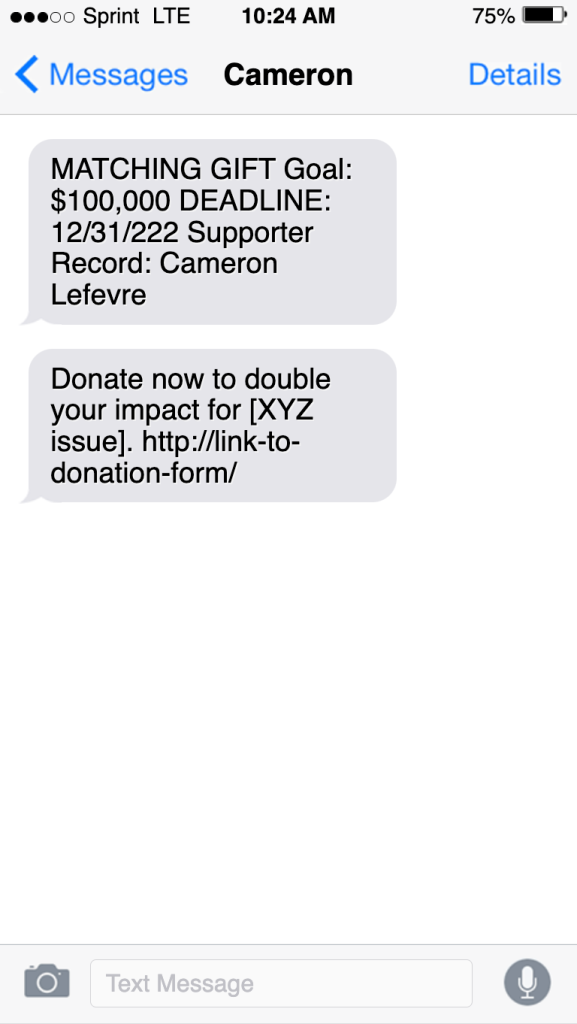With just days to go til the big day, we’re making our list and checking it twice 157 times. No, not THAT big day. The big day for fundraisers: December 31st. Our list is chock full of every single thing we can do to make the most of this super important moment. In case you missed it, we covered digital advertising for fundraising last week, and now we have another last-minute-friendly channel: text messaging.
Before we dig in, let’s get an important question that some nonprofits still wrestle with out of the way: Should nonprofits use text messaging for fundraising?
Answer: Yes! There’s some nuance to this, of course. Adding SMS to your marketing and fundraising efforts incurs some cost (e.g. SMS platform fee), so you’ll need to do some homework to make sure the return on investment is worth it. (Need some help figuring that out? That’s what we do!)
But in general, we believe it’s a worthwhile investment. Here’s why:
It’s generally accepted that, if you can reach your supporters and donors through more than one channel (e.g. email and text messaging vs. just email), you’ll raise more money. How much lift might we expect from layering on SMS? Working closely with our clients, we’ve conducted a number of A/B tests on this question over the years.
Our testing has shown that adding text messaging to an existing email fundraising program can increase the amount of revenue raised per person by 30% — and we’ve seen it go much higher for some groups!
That lift is across all giving channels too. It’s not just that people give in response to the text message, they also give more through other channels.
So, yeah, we’re allllll in on SMS fundraising.
(Ok, TBH, if you don’t already have a text messaging program right now, you’re not likely to get one up and running to use for December 31st. That’s ok! If you’re thinking about starting a text messaging program, now’s a good time to pay close attention to what other nonprofits are doing for end-of-year fundraising.)
Now, let’s supercharge those text messages.
1) Send longer text messages
While a standard SMS is limited to 160 characters, it is possible to send texts that are longer. These are concatenated SMS messages (sometimes referred to as multipart SMS).
As of today, concatenated text messages are supported by all major carriers in the United States, though some older phones may not support them. For phones and carriers that support concatenated messages, the messages look like any other text message, just longer. For phones/carriers that don’t support concatenated messages, the recipient will receive the text broken into a series of shorter texts. (Can you tell we dig the word concatenate?)
In our experiments, we found that longer text messages can yield stronger conversion rates than shorter messages.
- In one test, a text message with 126 characters resulted in a 20% increase in fundraising response rate over a text message with 70 characters.
- In another test, a 280-character text message increased fundraising response rate by 33% — and increased revenue per recipient by 50% — versus a text message with 131 characters.
To be clear, we haven’t determined the optimal upper limit of text message length, and we’re definitely not saying you should go send a text message with 1,600+ characters! But, we do think it’s worth experimenting with longer messages (and we’d love to hear about any of your long message experiments too!).
2) Consider sending an MMS
MMS is similar to concatenated SMS in that it allows you to send longer messages. But, importantly, MMS can also include media (e.g. an image, an animated gif, a video). This additional feature comes at a cost: MMS messages can cost two or three times more to send (cost may vary by SMS platform). That raises the question:
Does sending an MMS raise more money than an SMS to justify the higher cost?
Sometimes!
In our testing, which typically included a static image in the MMS, we found MMS messages increased fundraising response rates by 30%–50% over a standard SMS (with 160 characters or less). For our clients, this more than justified the higher cost of sending the MMS over an SMS.
It doesn’t always win though. The type and quality of the media included in the MMS are certainly factors. And we have found that sometimes a longer (concatenated) SMS performs just as well as or better than an MMS (when both use the same text and the MMS just adds an image).
This is the kind of thing we recommend testing during your year-end fundraising campaign so that you can learn what works best for your supporters.
3) Consider a very simple, direct ask
We’ve covered length and format, but what should you actually write in your text message? Here’s one approach that has worked well: a very simple, direct ask. Here’s what I mean by that:

We’ve tested this approach several times against typical text messages that are more like full sentences, and found that the above approach increased the donation response rate by up to 50%–80%! As with MMS though, it doesn’t always win, so it’s another tactic to test to determine if it works with your audience.
And there you have it — three easy things you can do for December 31st that you can add to your list. Have questions about any of the above or how else you might leverage text messaging for fundraising (or advocacy/organizing)? Drop us a line!
Here’s to an abundant and successful year-end season. We’re crossing our fingers for all of you!



